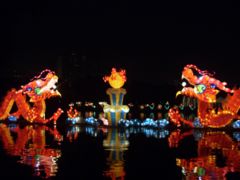
Back مهرجان منتصف الخريف Arabic Festa de la Mitja Tardor Catalan Báik-nguŏk-cáik CDO Svátek středu podzimu Czech Efterårsfestival Danish Mondfest German Luna Festo Esperanto Fiesta del Medio Otoño Spanish Kesksügise festival Estonian جشن نیمه پاییز Persian
| Mid-Autumn Festival | |
|---|---|
 Festival decorations in Beijing | |
| Also called | Moon Festival, Mooncake Festival |
| Observed by | Chinese people |
| Type | Cultural, religious |
| Significance | To commemorate and celebrate the end of the autumn harvest |
| Celebrations | Lantern lighting, mooncake making and sharing, courtship and matchmaking, fireworks, family gathering, dragon dances, family meal, visiting friends and relatives, gift giving |
| Observances | Consumption of mooncakes and cassia wine |
| Date | 15th day of the 8th month of the Chinese lunar calendar |
| 2024 date | 17 September |
| 2025 date | 6 October |
| 2026 date | 25 September |
| Frequency | Annual |
| Related to | Chuseok (Korea), Tsukimi (Japan), Tết Trung Thu (Vietnam), Uposatha of Ashvini or Krittika (Cambodia, Laos, Myanmar, Sri Lanka, and Thailand) |
The Mid-Autumn Festival (for other names, see § Etymology) is a harvest festival celebrated in Chinese culture. It is held on the 15th day of the 8th month of the Chinese lunisolar calendar with a full moon at night, corresponding to mid-September to early October of the Gregorian calendar.[1] On this day, the Chinese believe that the moon is at its brightest and fullest size, coinciding with harvest time in the middle of autumn.[2]
The Mid-Autumn Festival is one of the most important holidays in Chinese culture; its popularity is on par with that of Chinese New Year. The history of the festival dates back over 3,000 years.[3][4] Similar festivals are celebrated by other cultures in East and Southeast Asia.
During the festival, lanterns of all size and shapes – which symbolize beacons that light people's path to prosperity and good fortune – are carried and displayed. Mooncakes, a rich pastry typically filled with sweet-bean, egg yolk, meat or lotus-seed paste, are traditionally eaten during this festival.[5][6][7] The Mid-Autumn Festival is based on the legend of Chang'e, the Moon goddess in Chinese mythology.
- ^ Yang, Fang (12 September 2011). "Mid-Autumn Festival and its traditions". Archived from the original on 13 April 2012.
- ^ Pinky Chng; William Tan (19 September 2020). "Mooncakes, lanterns and legends: Your guide to the Mid-Autumn Festival in Singapore". AsiaOne. Retrieved 16 October 2024.
- ^ "Moon Festival – The Chinese Mid Autumn Festival". 3 June 2021.
- ^ Roy, Christian (2005). Traditional Festivals: A Multicultural Encyclopedia, Volume 1. ABC-CLIO. pp. 282–286. ISBN 978-1576070895.
- ^ "Mid-Autumn Festival in Other Asian Countries". www.travelchinaguide.com.
- ^ "A Chinese Symbol of Reunion: Moon Cakes – China culture". kaleidoscope.cultural-china.com. Archived from the original on 5 May 2017. Retrieved 4 October 2017.
- ^ "Back to Basics: Baked Traditional Moon Cakes". Guai Shu Shu. 10 August 2014. Retrieved 4 October 2017.